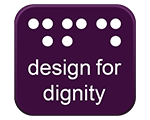Guidance on online retailing
What is the benchmark for accessibility
When considering the accessibility of your website, software applications or intranet, there is plenty of guidance available, but it can seem quite technical and it can be difficult to determine whether you are ‘doing it right’. This section seeks to de-mystify the acronyms and language and explain how you can determine if your sites are accessible.
What is WCAG?
Web Content Accessibility Guidelines (WCAG) 2.0 is the international standard used by web developers to ensure that websites are accessible to people with disability. Meeting the standards means your website will be accessible to the widest possible audience, but it may not meet the needs of all combinations and degree of disability.
WCAG Levels
The Standards have three levels: A, AA and AAA. Unsurprisingly AAA is best, but is seen as aspirational and most organisations and people with disability find AA level gives a level of access which lets people do most things online.
Website accessibility principles
Under the web accessibility guidelines, there are four foundation principles which are essential for the development of web content. In simple terms, the four principles for good accessible website design are:
- Perceivable: Users must be able to perceive the information being presented (it can't be invisible to all of their senses).
- Operable: Users must be able to interact with your website (it cannot require interaction that a user cannot perform).
- Understandable: The content or operation of your website cannot be beyond the understanding of the user.
- Robust: Users of a wide variety of assistive technologies must be able to use your site now, and in the future as technologies evolve.
What types of things do the standards cover?
For each principle, there are one or more guidelines that assist web developers and those commissioning work on the web to better understand what is required to deliver on each principle.
- Perceivable
- Provide text alternatives for any non-text content so that it can be changed into other forms people need, such as large print, braille, speech, symbols or simpler language.
- Provide alternatives for time-based media.
- Create content that can be presented in different ways (for example simpler layout) without losing information or structure.
- Make it easier for users to see and hear content including separating foreground from background.
- Operable
- Make all functionality available from a keyboard.
- Provide users enough time to read and use content.
- Do not design content in a way that is known to cause seizures.
- Provide ways to help users navigate, find content, and determine where they are.
- Understandable
- Make text content readable and understandable.
- Make web pages appear and operate in predictable ways.
- Help users avoid and correct mistakes.
- Robust
- Maximize compatibility with current and future user agents, including assistive technologies.



